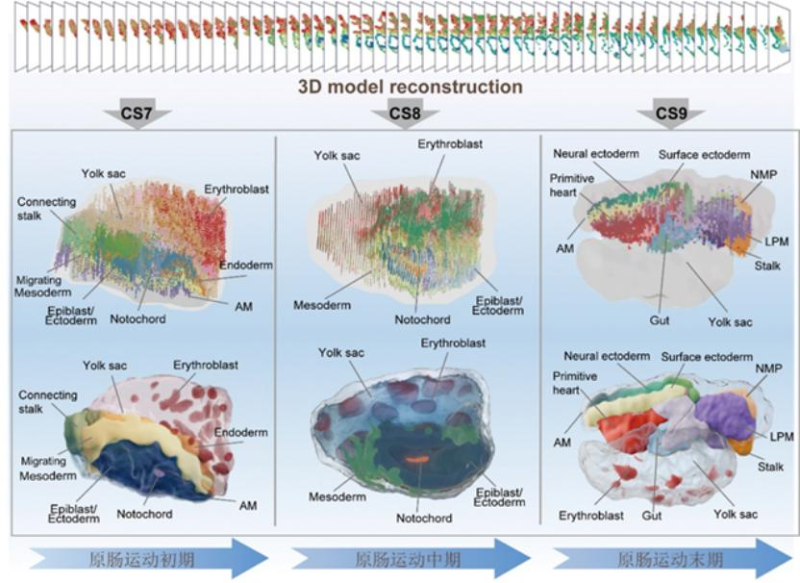Weekly Advanced Technologies〔76〕

Weekly Advanced Technologies〔76〕| Scientists Map Human Embryo's Blueprint in Groundbreaking 3D Model; Breakthrough Graphene Patch Heals Brain Injuries Without Implants Using Ultrasound
After two years of collaborative research, a team from the Beijing Institute of Technology, the Institute of Zoology of the Chinese Academy of Sciences, and China Agricultural University has successfully mapped the early developmental trajectory of human organs. Their groundbreaking findings have now been published, offering new insights into organogenesis.
Neural stem cells (NSCs) can differentiate into functional neurons, offering significant potential for neural circuit remodeling and nerve injury repair. In a groundbreaking interdisciplinary collaboration, Prof. Hong Liu—a leading researcher in crystalline materials at Shandong University—along with teams from Qilu Hospital and the School of Basic Medical Sciences, has developed a novel barium titanate-reduced graphene oxide (BT-rGO) piezoelectric nanoscaffold. This innovation presents a promising new approach for treating traumatic brain injuries (TBI).
Based on the weekly diary of technology provided by the daily list of the NCSTI online service platform, we launch the column "Weekly Advanced Technologies" at the hotlist of sci-tech innovation. Today, let's check out No.76.
1. Cell Stem Cell丨Scientists Map Human Embryo's Blueprint in Groundbreaking 3D Model

A collaborative study was conducted by the research group of XIAO Zhenyu from the School of Life Science at Beijing Institute of Technology, researchers YU Leqian and GUO Jingtao from the Institute of Zoology, Chinese Academy of Sciences, and the team of Professor WEI Yulei from China Agricultural University. Over the course of two years, focusing on key processes in early human embryonic development, they established a systematic research framework. Through digital reconstruction of spatial transcriptomic profiles from individual embryonic sections, the team successfully mapped an unprecedented developmental "blueprint."
In their latest research, the team has systematically unraveled the core signaling pathways and molecular machinery responsible for anterior-posterior axis patterning during human embryonic development at CS7 (initiation of gastrulation) and CS8 (conclusion of gastrulation) stages, while making the seminal discovery of a tail-organizing center. Leveraging these findings, they achieved a landmark feat: creating the first global 3D digital reconstruction of a human CS9 embryo, which captures the architectural transition as gastrulation culminates and organogenesis commences. This work fundamentally redefines our understanding of early human organ specification.
2. Nature Materials丨Breakthrough Graphene Patch Heals Brain Injuries Without Implants Using Ultrasound

Neural stem cells (NSCs) possess the capacity to differentiate into functional neurons for neural circuit remodeling, demonstrating significant therapeutic potential for nerve injury repair. However, their clinical translation has been hindered by inherent limitations including low differentiation efficiency and protracted maturation timelines. Recent advances reveal that electrical stimulation exhibits dual functionality: modulating neural activity while concurrently enhancing NSC differentiation into functional neurons to facilitate neural network reconstruction.
Conventional approaches relying on implanted electrodes present substantial drawbacks, such as secondary tissue damage, chronic immune rejection, and infection risks. This technological bottleneck has driven the exploration of piezoelectric nanomaterials as an innovative alternative. These materials generate localized piezoelectric potentials through deformation under ultrasonic excitation, thereby enabling wireless, non-invasive in situ stimulation of target cells and tissues—a paradigm shift in neuromodulation strategies.
3. Advanced Materials丨The Future of Dielectric Ceramics: Can We Achieve Both Superior Energy Storage and Temperature Resistance?"

The design of tri-relaxor–antiferroelectric nanocomposite ceramic
Energy storage dielectrics are the backbone of modern power systems—from renewable energy grids to electric vehicles. Their efficiency dictates how reliably these systems operate, driving researchers to develop advanced dielectric materials with superior energy storage capabilities.
A major hurdle persists: materials that work well at room temperature often fail under heat, drastically losing their energy storage capacity. This makes them unreliable for applications where temperatures rise, such as in electric vehicles or renewable energy systems. The root causes are twofold: heat disrupts the material’s polarization (critical for energy storage), while rising temperatures also trigger excessive electrical leakage and failures. Existing materials simply can’t handle the extreme demands of high-temperature, high-reliability energy storage devices.
To address this challenge, researchers from Xi’an Jiaotong University proposed an innovative solution: introducing antiferroelectric inducer ions (Bi³⁺, Zn²⁺, Nb⁵⁺) into a tricritical ferroelectric material, (Ba,Sr)(Ti,Sn)O₃, while controlling the sintering process to achieve localized enrichment. This results in a self-assembled, nanoscale phase-separated composite structure combining tricritical relaxor (triple-relaxor) and antiferroelectric properties.
The study revealed that the tri-relaxor–antiferroelectric nanocomposite ceramic system (1-x)(Ba,Sr)(Ti,Sn)O₃ - xBi₁.₅ZnNb₁.₅O₇ simultaneously achieves high energy storage density, high energy storage efficiency, and excellent thermal stability. This breakthrough provides a novel strategy for developing next-generation high-performance dielectric ceramics that combine superior energy storage performance with temperature stability.